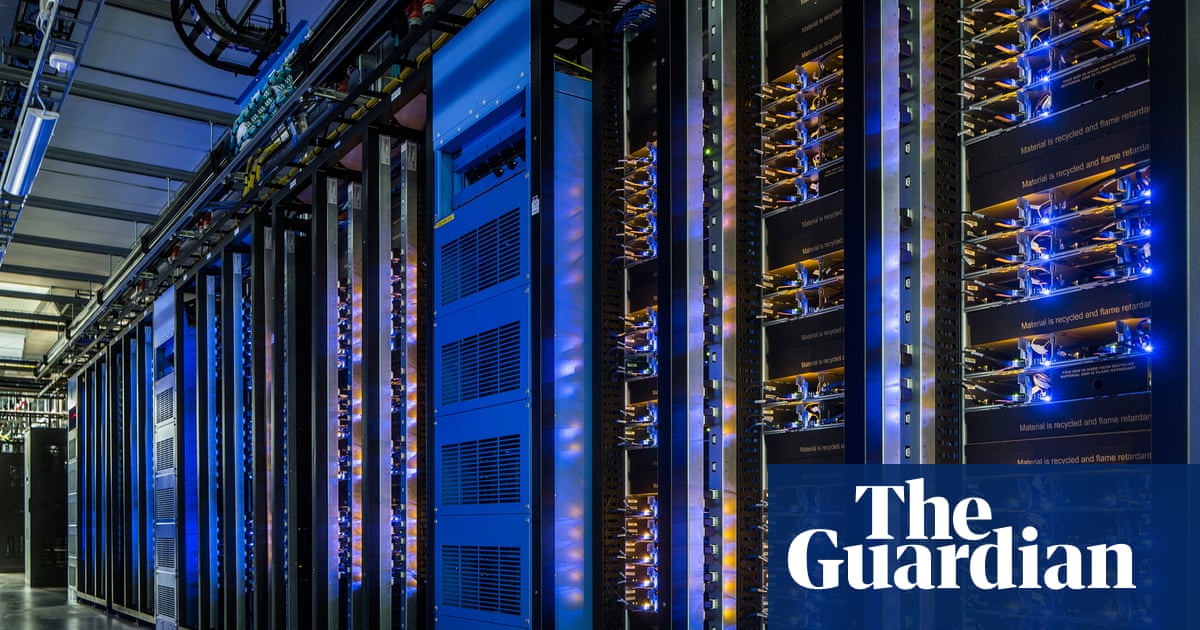A vast new datacentre to feed Britain’s rising demand for artificial intelligence could cause more greenhouse gas emissions than five international airports.
Elsham datacentre in Lincolnshire is on course to cost £10bn and its 15 power-hungry computer warehouses are projected to release five times the carbon dioxide ofBirmingham airport, including from take-offs and landings.
Aplanning applicationfor the facility nine miles east of Scunthorpe was submitted last month and a public consultation closes in three weeks.
Documents estimate the datacentre would consume 3.7bn kWh of energy, with annual CO2emissions of 857,254 tonnes when running at full tilt. This is based on the current mix of energy sources powering the National Grid.
The datacentre will also create so much excess heat that glasshouses are being proposed with capacity to produce more than 10 tonnes of tomatoes a day.
Global tech firms are struggling to meet their carbon-cutting goals. By 2030, carbon dioxide emissions from AI datacentres will be six times the 2023 level, according toresearchby the Öko-Institut in Germany. Greenpeace has called for commensurate renewable energy capacity to be added to national grids at the same time as new datacentres are built.
Microsoft recently admittedthat five years after it committed to becoming zero carbon by 2030, its total emissions had risen by 23% due to factors including AI expansion. This week Meta signed a 20-year deal with anuclear power stationin Illinois, while Amazon and Google are also investing in nuclear energy to fuel the race for AI dominance.
Datacentres are needed to train AI models and run AI searches, which are now routinely offered to billions of people by Google and Meta and which require four to five times more computing power,according to estimates.
Climate experts believe AI could help the fight against global heating by making power grids work more efficiently or accelerating the development of new zero-carbon technologies.
Martha Dark, a co-executive director of Foxglove, a non-profit organisation based in London campaigning for “a fairer tech future”, said the Elsham planning application put two key UK government missions on a collision course.
“The prime minister has talked up datacentres powering generative AI as the magic beans to miraculously sprout Britain’s withered economy into life but also made a promise at the election to get toxic pollution out of our air and deliver net zero by 2050,” she said. “It’s decision time: does the government want an economic plan that’s best for Britain, or one that’s best for Amazon, Google and Meta?”
Planning documents state: “Elsham Tech Park Ltd will endeavour to purchase green power for the facility, where possible.” The backers believe CO2emissions could be lower than the 850,000 tonnes a year figure if the National Grid becomes greener by the time the datacentre is due to be switched on in 2029.
The developer has ruled out on-site renewables as impractical. If the system ran on biomass energy it would require the daily delivery of 100 large lorry loads of wood chips. Wind energy would require 10,000 20-metre wind turbines, while an area five times the size of the Glastonbury festival site would be needed if it were to be powered by photovoltaic panels.
Sign up toDown to Earth
The planet's most important stories. Get all the week's environment news - the good, the bad and the essential
after newsletter promotion
A government spokesperson said it was “alert to the power demands which will drive AI development” and it would use “responsible, sustainable sources”, with advanced modular reactors, which create nuclear power, playing “a particularly important role”.
“We’re shaking up the planning rules to make it easier to build nuclear power stations across the country,” the spokesperson said.
Peter Kyle, the secretary of state for science and technology, has called datacentres “the engines of the AI age”, and the government has saidit is targetinga “rapid build-out” to boost the UK’s capacity for building and running AI models.
Last month the deputy prime minister, Angela Rayner, overruled a local council that had rejected a plan for a £1bn datacentre at Abbots Langley in Hertfordshire,citingthe “clear and pressing need for new datacentre capacity”.
Robert Waltham, the leader of NorthLincolnshirecouncil, which covers Elsham, said: “You have to be aware of the management of resources but we also have to have significant investment in the UK, and AI is contributing to health and supporting the most vulnerable people. This is not just about Google search – AI is improving medical science and our productivity.”
He cited the example of how the council was deploying AI chatbots to help older people stay on top of their medicines, enabling them to stay at home longer rather than moving into residential care.
A spokesperson for Greystoke, which owns Elsham Tech Park Ltd, said the project would create 900 jobs. “The region is an ideal location for AI datacentres due to the significant investment already made in developing the UK’s most advanced clean energy cluster,” they said. “It has access to a third of the UK’s offshore wind energy as well as access to 66% of the UK’s licensed carbon capture and storage.”
